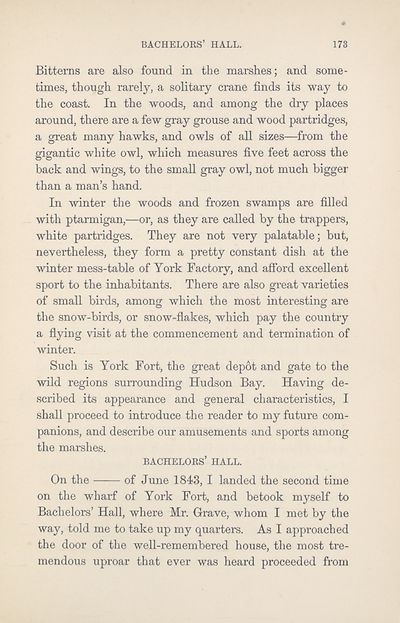Download files
Complete book:
Individual page:
Thumbnail gallery: Grid view | List view

BACHELORS’ HALL.
173
Bitterns are also found in the marshes; and some¬
times, though rarely, a solitary crane finds its way to
the coast. In the woods, and among the dry places
around, there are a few gray grouse and wood partridges,
a great many hawks, and owls of all sizes—from the
gigantic white owl, which measures five feet across the
back and wings, to the small gray owl, not much bigger
than a man’s hand.
In winter the woods and frozen swamps are filled
with ptarmigan,—or, as they are called by the trappers,
white partridges. They are not very palatable; but,
nevertheless, they form a pretty constant dish at the
winter mess-table of York Factory, and afford excellent
sport to the inhabitants. There are also great varieties
of small birds, among which the most interesting are
the snow-birds, or snow-flakes, which pay the country
a flying visit at the commencement and termination of
winter.
Such is York Fort, the great depot and gate to the
wild regions surrounding Hudson Bay. Having de¬
scribed its appearance and general characteristics, I
shall proceed to introduce the reader to my future com¬
panions, and describe our amusements and sports among
the marshes.
bachelors’ hall.
On the of June 1843, I landed the second time
on the wharf of York Fort, and betook myself to
Bachelors’ Hall, where Mr. Grave, whom I met by the
way, told me to take up my quarters. As I approached
the door of the well-remembered house, the most tre¬
mendous uproar that ever was heard proceeded from
173
Bitterns are also found in the marshes; and some¬
times, though rarely, a solitary crane finds its way to
the coast. In the woods, and among the dry places
around, there are a few gray grouse and wood partridges,
a great many hawks, and owls of all sizes—from the
gigantic white owl, which measures five feet across the
back and wings, to the small gray owl, not much bigger
than a man’s hand.
In winter the woods and frozen swamps are filled
with ptarmigan,—or, as they are called by the trappers,
white partridges. They are not very palatable; but,
nevertheless, they form a pretty constant dish at the
winter mess-table of York Factory, and afford excellent
sport to the inhabitants. There are also great varieties
of small birds, among which the most interesting are
the snow-birds, or snow-flakes, which pay the country
a flying visit at the commencement and termination of
winter.
Such is York Fort, the great depot and gate to the
wild regions surrounding Hudson Bay. Having de¬
scribed its appearance and general characteristics, I
shall proceed to introduce the reader to my future com¬
panions, and describe our amusements and sports among
the marshes.
bachelors’ hall.
On the of June 1843, I landed the second time
on the wharf of York Fort, and betook myself to
Bachelors’ Hall, where Mr. Grave, whom I met by the
way, told me to take up my quarters. As I approached
the door of the well-remembered house, the most tre¬
mendous uproar that ever was heard proceeded from
Set display mode to:
![]() Universal Viewer |
Universal Viewer | ![]() Mirador |
Large image | Transcription
Mirador |
Large image | Transcription
| Antiquarian books of Scotland > Adventure and adventurers > Hudson Bay, or, Everyday life in the wilds of North America > (177) |
|---|
| Permanent URL | https://digital.nls.uk/132736152 |
|---|
| Description | Thousands of printed books from the Antiquarian Books of Scotland collection which dates from 1641 to the 1980s. The collection consists of 14,800 books which were published in Scotland or have a Scottish connection, e.g. through the author, printer or owner. Subjects covered include sport, education, diseases, adventure, occupations, Jacobites, politics and religion. Among the 29 languages represented are English, Gaelic, Italian, French, Russian and Swedish. |
|---|

